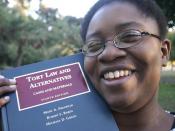Tort law is, to a great extent, social engineering by the courts. As society evolves, the courts? concept of what interests we have that are worth protecting also evolves. The courts impose duties on us not to injure the protectable interests of others.
The leading remedy for accidental injury in this country is the negligence cause of action. Existence of a duty and proximate causation, both of which turn largely on the notion of foreseeability, are the key elements for a plaintiffs recovery. A plaintiff?s own carelessness can lead to a reduction or a bar altogether on recovery.
Among intentional torts, assault and battery protect invasions of our mind and body, defamation protects our good reputation in the community, false imprisonment protects the right to come and go as we please, and trespass protects our right to enjoyment or our real property. To successfully pursue each tort, the plaintiff must prove a variety of specified elements.
Each tort involves an intentional act by the defendant. Each has a variety of defenses ranging from self-defense for assault and batter, to absolute and qualified privileges for defamation, to consent and legal right for false imprisonment and trespass.
Intentional torts that are also worth noting included the four varieties of invasion of privacy tort, intentional infliction of emotional distress (which has been often used successfully against aggressive collection agencies), fraud, conversion, and nuisance (which involves lesser invasions of real property than does trespass).
Employers are liable for the torts of their employees committed within the scope of authority. And joint tortfeasors (persons who commit torts) are each potentially liable for the entire judgement awarded to the plaintiff (though the plaintiff cannot have a double recovery). Rapid change in the tort system and escalating monetary awards have led many legislatures to consider strong measures...


